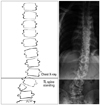Abstract
Purpose
Materials and Methods
Results
Conclusion
Figures and Tables
 | Fig. 1Different scoliosis curve pattern according to chest radiographs and thoraco-lumbar standing radiographs (TLSR). (A) Shows screened case as right thoracic curve scoliosis in chest radiographs, but it was confirmed as double major curve convexity right to left by TLSR. (B) Shows a lumbar curve scoliosis case who was screened as normal spinal curvature in chest radiographs. |
 | Fig. 2A scatterplot with raw data and corresponding fitted regression line showing the distribution and relation of Cobb angle between chest radiographs and TLSR (r=0.903). TLSR, thoraco-lumbar standing radiographs. |
 | Fig. 3Congenital vertebral abnormalities with hemivertebra of the 4th lumbar spine. The right lumbar curve on TLSR was misinterpreted as left lumbar curve on chest radiographs due to restricted field of sight. TLSR, thoraco-lumbar standing radiographs. |
Table 1

NL, normal spinal curves (Cobb angle of less than 5 degrees); RtT, right thoracic curve; RtTL, right thoraco-lumbar curve; RtL, right lumbar curve; DCRL, double major curve convexity right to left; DCLR, double major curve convexity left to right; LtT, left thoracic curve; LtTL, left thoraco-lumbar curve; LtL, left lumbar curve.
The number in brackets ( ) represents cases with Cobb angle differences of less than five degrees between chest radiographs and TLSR.
*A case of congenital vertebral abnormality with hemivertebrae of the 4th lumbar spine.
†A case of congenital vertebral abnormality with bilateral failure of segmentation from the 2nd to 4th lumbar spine.
Table 2

Table 3

Table 4





 PDF
PDF ePub
ePub Citation
Citation Print
Print




 XML Download
XML Download